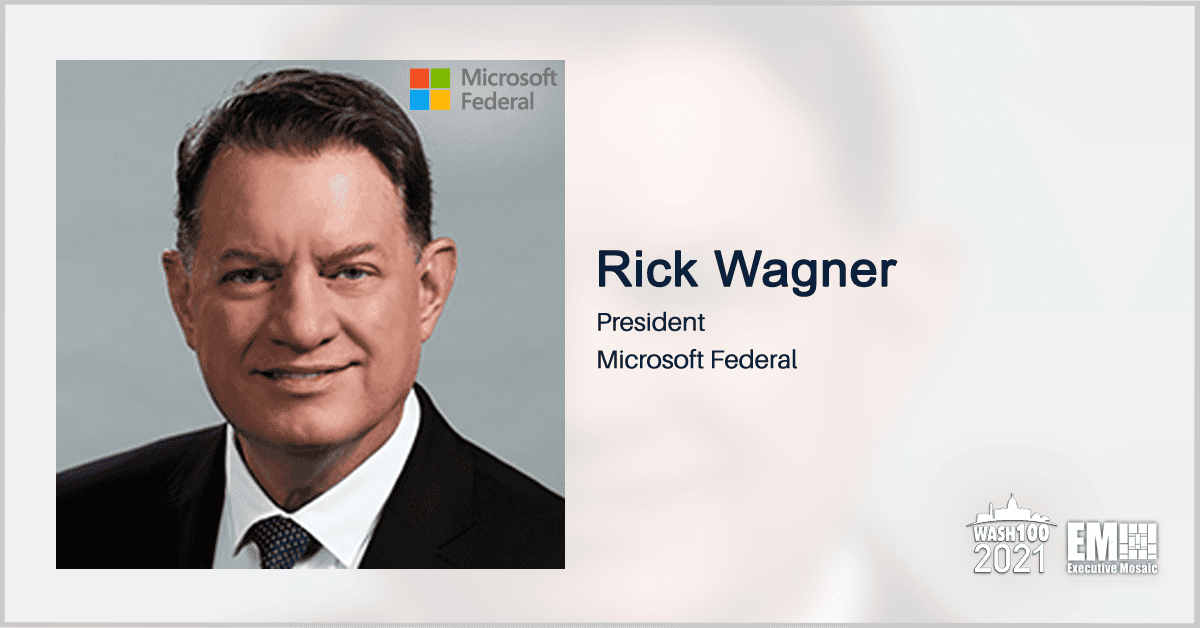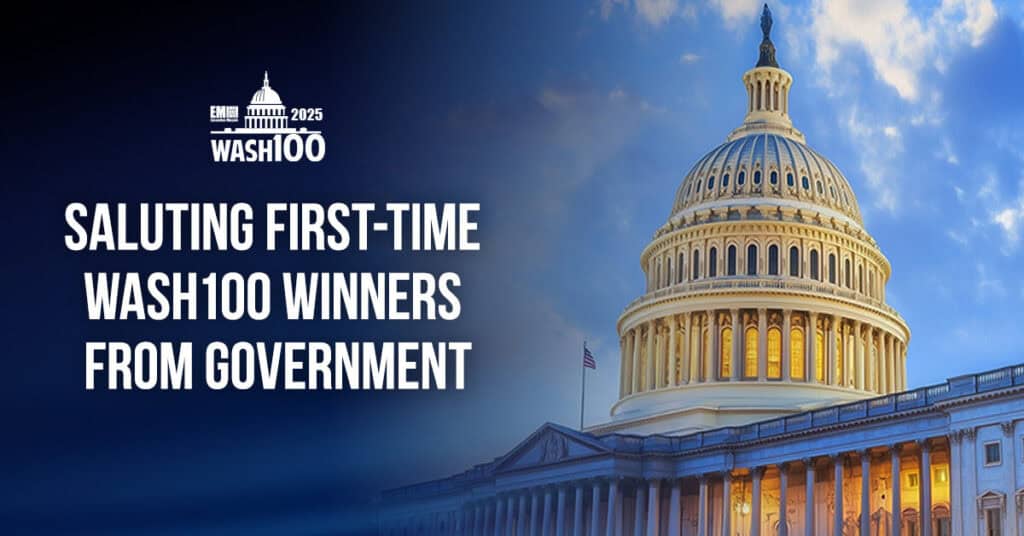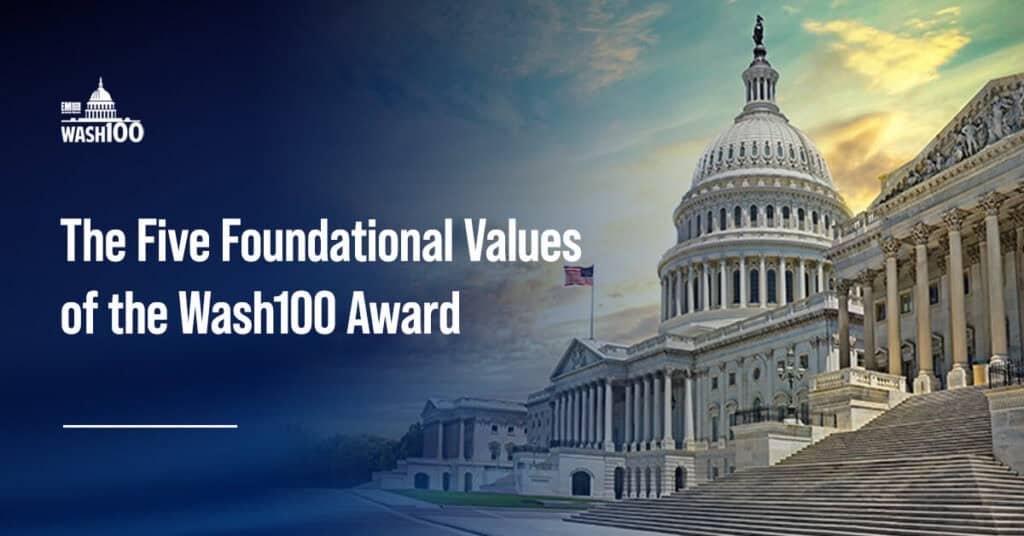Rick Wagner, president of Microsoft Federal and a four-time recipient of the Wash100 Award, recently spoke with ExecutiveBiz for his latest Executive Spotlight interview with the publication to discuss Microsoft’s investments into cybersecurity and the FastTrack program to improve our national security efforts and other areas of IT modernization for cloud infrastructures.
In addition, Rick Wagner also spoke with ExecutiveBiz about the results of the Digital Defense Report, the development of edge devices and how Azure Government Cloud is helping federal agencies as well as Azure Orbital and the development of Microsoft's secure satellite network.
“I think the biggest takeaway for me on this was the focus on the United States. Nearly 50 percent of all nation state attacks are directed at the U.S, and half of those are made directly against government agencies. But if you think about that data, that means half of them are focused on defense contractors and the other on commercial entities.”
You can read the full Executive Spotlight with Rick Wagner below:
ExecutiveBiz: Thank you and Microsoft for its ongoing contributions to the federal sector and its core initiatives. What can you tell us about the company’s investments into cybersecurity and the FastTrack program to improve our national security measures and other areas such as the modernization of our legacy and cloud infrastructures?
“I think the most important thing is that Microsoft recognizes that as one of the major technology providers for the federal government, we have a huge responsibility in terms of protecting our national critical assets. Obviously, cybersecurity is a big part of that mission.
That’s why our vice-chair and president Brad Smith jumped right in when the White House reached out and started the conversation. Microsoft has always invested heavily in cybersecurity. However, I think the rise in ransomware and IP that we knew that we needed to do more. It came down to us having the conversation and just making a commitment.
Thus far, it’s been $150 million around technical services to help the government move to the cloud and replace its old infrastructure. We have our fast track program that is specifically geared around modern work, where we have engineers who can help design the infrastructure. We also have our customer success unit and cloud solution architects that can help develop new cloud solutions for our customers.
In my mind, as we move to more secure architectures, zero trust architecture and move to the cloud, our customers won’t need to focus their attention on maintaining and keeping up to date on patching. That will already happen automatically within the system. We are looking to help our customers use our more advanced security tools, and we're even doing some financial incentives to help accomplish that.
The other piece to mention is the supply chain. We've put together an entire, what we call a ‘V team,’ a virtual team across Microsoft to look at the supply chains and develop a supply chain integrity model to help us to look through an entity's supply chain and make it more robust.”
ExecutiveBiz: Congrats on releasing the Digital Defense Report. What can you tell us about the most significant insights the report collected in regards to cybercrime, our supply chain security and hybrid work changes?
“I think the biggest takeaway for me on this was the focus on the United States. Nearly 50 percent of all nation-state attacks are directed at the U.S, and half of those are made directly against government agencies.
But if you think about that data, that means half of them are focused on defense contractors and the other on commercial entities. This is a pervasive problem. It's not just spy versus spy, right? It's not just a nation-state attacking another nation-state. It's all across the infrastructure.
The lesson that we take from this is you have to be vigilant and you have to be patching. You need to implement zero-trust principles. The idea that you’re safe because you have a firewall, or because you have the latest security tool is short-sighted thinking.
‘You can never trust, you must always verify.’ I think that's the focus that we're pushing is the idea around building those zero trust architectures and always verifying. President Biden recently put out an executive order focused on cloud with purity zero trust architectures.
We've been working closely with federal partners and trying to come up with ways to enhance government security. We've published a series of blogs. There's a lot of information that we've put out about establishing zero trust architectures, improving cloud security, protecting devices and endpoints. The whole idea of securing critical software is imperative.”
Don’t miss Microsoft’s upcoming US Public Sector Summit on Dec. 2nd featuring numerous thought leaders from across the federal landscape on delivering cybersecurity, sustainability, mission impact, data-driven excellence, workforce skills, research and innovation.
Join the conversation with federal, state, local government, and education leaders and learn how they have responded to recent disruption and what lies ahead, as we explore the solutions that will advance our nation and world.
Join us for the US Public Sector Summit to equip your organization to handle the challenges of the present and future. Visit Microsoft to register for this can’t miss US Public Sector Summit.
ExecutiveBiz: Microsoft has made several announcements regarding its Azure Government Cloud over the past year. Can you detail some of those updates and describe how they are helping the federal government achieve its mission, especially when it comes to edge devices?
“I think that the term mission cloud is really important. I want to make sure that people understand that the investments we're making are geared towards that focus on mission. How do we drive improved outcomes for our customers? When I talk with CEOs, I tell them that I want to give them secure collaboration and do that in a way that helps them to manage their enterprise.
How do we make that more cost-effective for them? Because what I'd really like to see is for the government to start to take advantage of some of these mission-oriented cloud capabilities that are available. And to that end, we recently received accreditation on our Azure government top-secret cloud. We now have cloud capabilities across all security levels.
It has more than 60 infrastructure platform services, and we're continuing to build that out. We'll continue to focus on bringing cloud capabilities that work, not just at the enterprise level, but also at the edge. I think one of the important factors that we look at in terms of building out our cloud is for the edge. You've got to take an edge first.
This isn't about just building an enterprise capability and pushing it out to the edge. It's about building capabilities that are specifically designed for edge use. On that level, we've recently announced a bunch of services around mission critical devices on the tactical edge. In that portfolio, we've got Azure Stack Hub, Azure Stack Edge and others. These are basically different instincts and creations of edge devices. We also have an Azure Data Box. The data box allows the government to move large sets of data without limiting the bandwidth.
This is all part of efforts that we're taking to help the government operate at the edge in austere environments and be able to bring artificial intelligence and machine learning capabilities to that edge as well. I recently had a huge discussion about this but you don't necessarily have to move all the data from the edge back to the central processing point. You can keep it at the edge through AI. After that, you can determine what the most important workloads are, and then you only have to move the most important data across the long haul.
For instance, we worked with the Army Corps of Engineers and took a look at the effects of extreme weather in coastal communities. They were using supercomputer resources to model these extreme weather impacts, but they had to compete for that time with DOD.
To help them out, we were able to leverage supercomputing in the cloud to help them look at how to plan for storm surges and how they could design defenses in the case of this extreme weather. That's just one example of how we're using our cloud resources to augment the existing computer resources and is another strong indicator of the investment that we're making for our customer admission.”
ExecutiveBiz: Last time we spoke in July, we addressed the advancement of Microsoft Cloud and Azure capabilities. What would you like to say about Azure Orbital, the development of a secure satellite network as well as the future of satellite and space tech with Microsoft?
“As we build out our capabilities, we want to extend the cloud basically everywhere. I think it's both 5G at the edge. It’s orbital to connect all of this. I think the other thing that I would say is that we've got the largest set of dark fiber resources in the world. If you combine all of those, you can expand our cloud to basically all the reaches of the Earth in space.
Right now, we have three objectives in terms of agile space. The primary goal is to extend that conductivity. As I discussed earlier, through the ecosystem of all satellite providers, we've got a growing network that we can now extend our cloud across to allow people to access the cloud from anywhere. We're partnering with all the leaders in the space community, and being able to unblock supercomputing into more and more scenarios and places where they would not have necessarily had the reach in the past.
I think as satellite capabilities become more and more accessible, we'll be able to increase the reliability of providing cloud capabilities across that entire spectrum and providing more for mission assurance as well. I think if you combine the Azure Orbital with the rugged edge devices, 5G networks at the edge, we can create a robust computing environment at the edge. That's something that our customers really need and we’re working very hard to ensure they have that.”





